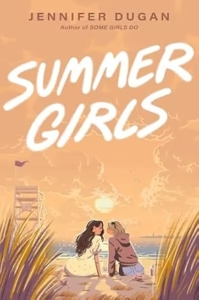Summer Girls
Jennifer Dugan
G.P. Putnam’s Sons Books for Young Readers
Published May 27, 2025
Amazon | Bookshop | Goodreads
About Summer Girls
From the author of Some Girls Do comes a YA sapphic romance about two girls from different sides of the tracks.
Cass has a rule about dating summer girls—just say no. Every year the idyllic beach town Cass’s working-class family calls home is flooded with summer girls, the obnoxious daughters of the rich, who stay in their families’ summer homes, sail their yachts, and generally make things unbearable for townies like Cass.
Birdie is the ultimate summer girl. She’s the daughter of a wealthy real estate developer dad and a social media influencer mom, and this summer Birdie happens to be in big trouble for accidentally crashing her boyfriend’s very expensive car.
As punishment, Birdie must spend the summer with her father at the beach—but it won’t be a vacation. He’s enlisted the help of Cass, whose dad works for him, to keep Birdie on the straight and narrow, including getting her a job as a beach parking lot attendant.
As the summer heats up, Cass realizes some rules are made to be broken, and Birdie just might be different from other summer girls. Soon they can’t help falling for one another . . . But will the love the two girls have discovered be strong enough to overcome their differences?
My Review
Summer Girls is the first book by Jennifer Dugan that I’ve read. I’d heard great things about her other books, especially Hot Dog Girl or Melt with You. So, she’s been on my list of authors to check out for a while. Now that I’ve read one of her books, I only want to read more.
I’ve read more than one book lately that shines light on the harmful effects of gentrification on neighborhoods and communities. Summer Girls shows the classism at the root and offers a version of a “Prince and Pauper” kind of romance.
I like that in Dugan’s world, people are more than one thing. The characters continually wrestle with the moral weight of their choices, and struggle to evaluate the decisions others make on a moral scale. For example, Birdie’s dad makes a lot of money buying up foreclosure properties and flipping them as vacation rentals, something which exacerbates the housing crisis for local residents. Yet, he appears to be a big supporter of Cass’s dad’s community organization which helps homeowners retain their property. So, is he a good guy or bad guy? Is he taking advantage of a system and pretending friendship with Cass’s dad to keep his enemies close, or is his support genuine? I liked that the story explored this question.
The romance between Cass and Birdie is also very sweet. It’s got an estranged friends to lovers vibe that was a lot of fun. Birdie is also bisexual and wrestles with some biphobia. I like that Dugan brought this to the page, too.
All in all, I think this is a lovely summer romance, especially perfect for a beach or vacation read.
Content Notes
Recommended for Ages 14 up.
Profanity/Crude Language Content
Strong profanity used periodically.
Romance/Sexual Content
Kissing. Someone posts a photo of a boy cheating on his girlfriend with another girl.
Spiritual Content
None.
Violent Content
One scene includes a car accident with minor injuries.
Drug Content
None.
Note: This post contains affiliate links, which do not cost you anything to use but help support this blog. I received a free copy of this book in exchange for my honest review. All opinions are my own.
